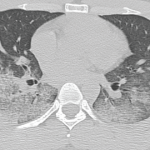ATLANTA—Although cyclophosphamide (CYC) may have transformed Wegener’s granulomatosis (WG) from an acute to chronic diagnosis, the risks associated with this drug have pushed rheumatologists and researchers to search for treatment alternatives.
A session at the 2010 ACR/ARHP Annual Scientific Meeting, “Treatment of Wegener’s Granulomatosis/Microscopic Polyangiitis: Understanding and Applying the Data from Recent Clinical Trials,” reviewed what the data have shown so far regarding CYC and other treatment options. [Editor’s Note: This session was recorded and is available via ACR SessionSelect at www.rheumatology.org.]
Philip Seo, MD, assistant professor of rheumatology at the Johns Hopkins Bayview Medical Center in Baltimore, discussed the evolution of WG treatment. For instance, he said longitudinal studies from the National Institutes of Health in 1992 demonstrated the value of CYC. “The good news about [the CYC] regimen is that it works,” Dr. Seo said. “There was 91% marked improvement and 75% complete remission,” he said. However, those improvements come at a cost.
“Forty-two percent of patients have permanent morbidity, 46% have serious infections, and 57% have infertility. There is an 11-fold increased risk of lymphoma and a 33-fold increased risk of bladder cancer. And that’s to say nothing of the risk of steroid-induced damage [often used during treatment]. These are numbers I frequently go over with patients,” Dr. Seo said.
Because of these risks, a variety of clinical trials have examined how to minimize CYC exposure, whether smaller doses or shorter treatment courses are more effective, or if avoiding the medication altogether is efficacious and safe, Dr. Seo said.
A Look at the Numbers
He discussed the results of a trial published in 2003 in the New England Journal of Medicine that found in patients with generalized vasculitis, the discontinuation of CYC and the substitution of azathioprine after remission appeared effective.1 This study included 155 patients with a new diagnosis of generalized vasculitis and a serum creatinine concentration of 5.7 mg/dL or less. Patients received at least three months of oral CYC and prednisolone. After remission, patients received either CYC (1.5 mg/kg/day) or azathioprine (2 mg/kg/day). Both patient groups received prednisolone and were followed for 18 months. Of the original 155 patients, 93% entered remission. In the azathioprine group, 15.5% of patients relapsed, while 13.7% of the patients in the CYC group relapsed.
“What you can take away from this is a short course of cyclophosphamide for remission induction, followed by a longer course of azathioprine for remission maintenance, is an effective treatment strategy for Wegener’s granulomatosis and microscopic polyangiitis,” Dr. Seo said.
However, studies that address the use of alternatives to azathioprine are of interest because not all patients can take that drug, Dr. Seo said. Possible alternatives include methotrexate and mycophenolate mofetil (MMF). A 2008 study from Pagnoux et al that randomized the use of azathioprine or methotrexate for anti–neutrophil cytoplasmic autoantibodies (ANCA)–associated vasculitis found identical relapse rates among patients in both groups.2 The study concludes that methotrexate and azathioprine appear to be similar alternatives for maintenance therapy after initial remission in WG and microscopic polyangiitis patients.
Dr. Seo said other research with mycophenolate mofetil shows different results. The International Mycophenolate Mofetil Protocol to Reduce Outbreaks of Vasculitides (IMPROVE) trial aimed to discover whether MMF is more effective than azathioprine to prevent ANCA-associated vasculitis.3 This open-label, randomized controlled trial took place at 42 centers in Europe over 42 months. Patients received either azathioprine (80 patients) or MMF (76 patients) after remission induction with CYA and prednisolone. Relapses occurred more often in the MMF group; there was an unadjusted hazard ratio of 1.69 for MMF. The study concluded that mycophenolate mofetil was less effective than azathioprine to maintain disease remission, although both treatments had similar adverse event rates.
However, Dr. Seo said, some research has shown the value of MMF for remission induction and maintenance in a group of patients with renal disease.4 A case series of 17 patients with microscopic polyangiitis and mild to moderate renal involvement received corticosteroids for six months and MMF two times a day. Patients continued to receive MMF for 18 months. Remission and stable renal function were the primary outcome measures; 13 of the 17 patients achieved these measures. “Overall, this seems like a very reasonable option,” Dr. Seo said.
Dr. Seo also addressed the question of whether pulse doses of CYC can equally treat patients with ANCA-associated vasculitis. He cited the 2009 Cyclophosphamide Daily Oral Versus Pulsed (CYCLOPS) trial in which 149 newly diagnosed patients who also had renal involvement received pulse CYC, amounting to 15 mg/kg every two to three weeks (76 patients) compared with 73 patients who received daily oral CYC (2 mg/kg/day).4 Both patient groups received prednisolone; once in remission, both patient groups received azathioprine. The two groups did not differ in their time to remission or in the proportion of patients who achieved remission at nine months. The cumulative dose in the daily oral group was larger than patients in the pulse group. “The IV cyclophosamide group was slightly more likely to relapse than the oral group,” Dr. Seo said. “Overall though, the message remains that short courses of cyclophosamide, either oral or IV, for remission induction, followed by longer use of a remission–maintenance agent such as methotrexate or azathioprine is safe and effective for the treatment of Wegener’s granulomatosis and microscopic polyangiitis.”
Biologic Agents for Wegener’s Granulomatosis
A presentation from pulmonologist Ulrich Specks, MD, professor of medicine at Mayo Clinic in Rochester, Minn., focused on data regarding biologic agents in the treatment of WG and microscopic polyangiitis. He zeroed in on the growing role of rituximab for these diseases, citing the results from a trial published in the New England Journal of Medicine regarding rituximab versus CYC for ANCA-associated vasculitis.5 The trial included 197 ANCA-positive patients from nine different centers with one of the two diseases. Patients received rituximab or CYC for remission induction. Glucocorticoids were tapered, and the study endpoint was disease remission with no prednisone use at six months.
Sixty-four percent of patients in the rituximab group reached the study’s endpoint compared with 53% in the CYC group. Rituximab use was considered as effective as CYC for patients with major renal disease or alveolar hemorrhage, Dr. Specks said.
“The primary results show that rituximab is not inferior to cyclophosamide and that there was no difference in treatment response to rituximab or cyclophosamide,” he said. “The treatment response to rituximab was superior to cyclophosamide in patients who entered the trial with a disease flare.”
Dr. Specks said that rituximab is “the first proven alternative” to cyclophosamide for remission induction in patients with severe ANCA-associated vasculitis. “This is of particular importance for patients who present with a severe disease flare or who want to preserve their fertility,” he said.
There are complementary results from the RITUXVAS trial, which Dr. Specks said compared rituximab use plus two infusions of CYC versus IV CYC for six months followed by oral azathioprine. Both patient groups received prednisone. “Over 12 months, one course of rituximab achieves the same results as cyclophosamide followed by azathioprine,” he said.
Rituximab appears to be an effective option for newly diagnosed patients with severe disease and severe relapses and is preferable for younger patients and those with PR3-ANCA, Dr. Specks said. However, he said its use does not come without some words of caution. “Rituximab is an immunosuppressive agent, and the infection risk seems similar to that of carefully monitored cyclophosamide followed by azathioprine,” he said.
The session ended with a review of some sample WG and microscopic polyangiitis case studies, where audience members had the chance to weigh in on how they would treat patients.
Vanessa Caceres is a medical writer in Bradenton, Florida.
References
- Jayne D, Rasmussen N, Andrassy K, et al. A randomized trial of maintenance therapy for vasculitis associated with antineutrophil cytoplasmic autoantibodies. N Engl J Med. 2003; 349:36-44.
- Pagnoux C, Mahr A, Hamidou MA, et al. Azathioprine or methotrexate maintenance for ANCA-associated vasculitis. N Engl J Med. 2008;359;2790-2803.
- Hiemstra TF, Walsh M, Mahr A, et al. Mycophenolate mofetil vs azathioprine for remission maintenance in antineutrophil cytoplasmic antibody-associated vasculitis: A randomized controlled trial. JAMA. 2010;304: 2381-2388.
- Silva F, Specks U, Kalra S, et al. Mycophenolate mofetil for induction and maintenance of remission in microscopic polyangiitis with mild to moderate renal involvement—a prospective, open-label pilot trial. Clin J Am Soc Nephrol. 2010;5:445-453.
- Stone JH, Merkel PA, Spiera R, et al. Rituximab versus cyclophosphamide for ANCA-associated vasculitis. N Engl J Med. 2010;363: 221-232.

